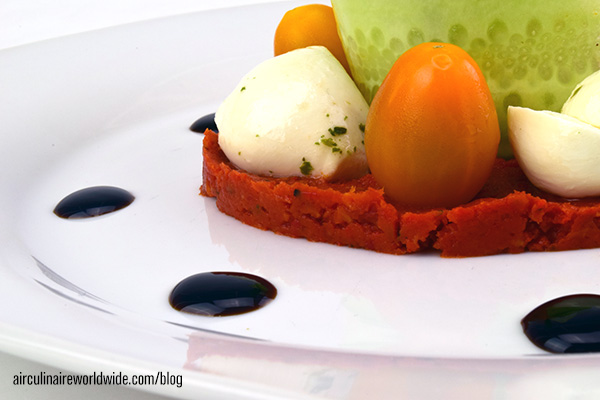In the world of in-flight catering for private aviation, we must constantly be on the lookout for specific dietary requirements and restrictions for our clients. This can come in many forms and be prompted by the laws of a religion, health matters, culture or personal lifestyle choices. One of the most widely known, yet sometimes misunderstood, is the vegetarian diet and, within that category, vegan. First, let’s explore the broader category of vegetarian diets and then look at the differences when a client is a vegan.
Lately, an increasing number of people are realizing you do not have to be a strict vegetarian to love vegetarian food. The recently coined term, “flexitarian,” describes this new category in which an individual eats a mostly vegetarian diet, but occasionally eats meat.
The next step toward a fully vegetarian diet is the pescatarian category. This term is used to describe those who abstain from eating all meat and animal flesh, with the exception of fish. Eggs and dairy products are still included in this diet. While some vegetarians d onot consider this to be a type of vegetarian diet, a growing number of people are adopting this diet for health reasons or as a stepping stone to a fully vegetarian diet.
When most people think of vegetarians, they typically are actually thinking of lacto-ovo vegetarians. People who who adhere to this diet do not eat beef, pork, poultry, fish, shellfish or animal flesh of any kind. However, they do eat eggs and dairy products, thus the term “lacto-ovo” vegetarian is used to describe this category since “lacto” comes from the Latin word for milk and “ovo” comes from the Latin word for for egg.
Also found within the vegetarian category is the macrobiotic diet. This diet, revered by some for its healthy and healing qualities, includes unprocessed vegan foods, such as whole grains, fruit and vegetables, and the occasional consumption of fish. Sugar and refined oils are avoided. Perhaps the most unique qualifier of the macrobiotic diet is its emphasis on the consumption of Asian vegetables (such as daikon) and sea vegetables (such as seaweed).
Now that we have an understanding of the types of vegetarian diets, we are ready to look at the vegan category. Veganism does not stop at diet, it is an entire lifestyle. People who follow a vegan diet do not eat meat of any kind and also do not eat eggs, dairy products, or processed foods containing these or other animal-derived ingredients (such as gelatin). Many vegans also refrain from eating food made using animal products that may not contain animal products in the finished process, such as sugar and some types of wine. While there is some debate as to whether certain food items (such as honey) or products (such as beeswax) fit into a vegan diet, most vegans will avoid any items produced by an animal, due to animal cruelty concerns. Vegans also abstain from using or wearing any animal-based materials, such as leather.
Within veganism is a subcategory called the “raw vegan” or “raw food” diet. This diet consists of unprocessed vegan foods that have not been heated above 115 F (46 C). “Raw foodists,” a term used to describe followers of this diet, believe that food items cooked above this temperature have lost a significant amount of nutritional value and are harmful to the body.
As with all dietery requirements, when working with a vegetarian or vegan client, it is important to understand and communicate the exact type of diet to your preferred in-flight caterer. This will ensure you receive the appropriate items and give them a stellar dining experience.
Questions?
If you have any questions about this article or about in-flight catering, contact weborders@airculinaire.com.






